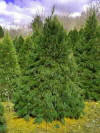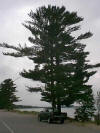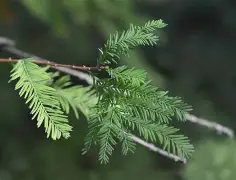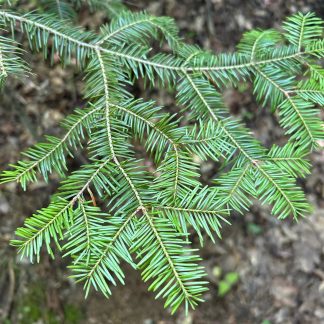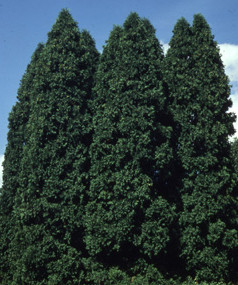Description
A White Pine is a majestic evergreen when planted as a specimen tree or as a group. White Pine needles are long and soft in groups of 5. The needles of the white pine last for two years, the older needles falling off in the fall of the second year. The needle color is bluish-green, length of 3-5 inches and are very soft. The Korean pine is also a 5 needle pine but has coarser, curved needles and is a much slower growing tree. The male flower is 1/3″ long, yellow and somewhat attractive (see photo below). The cones are erect and spreading the first year, 4-7″ long browning and opening the second fall. The seeds are 1/4″ long, brown and average 26,000 per pound. The cones can be quite messy on occasional years littering the lawn and making life tough for your lawnmower. The white pine seed have a long wing probably for dispersal. The seed is eaten by red squirrels, crossbills and pine siskens. Beautiful thin, grey-brown bark matures to dark, maple like bark. The white pine branches are quite brittle and one must take care when climbing the tree to keep your feet near the trunk when standing on a branch. Ice storms can devastate white pine due to the brittleness of the branches. The wood is light, soft, weak, compact, straight grained, easily worked and light brown. A cubic foot of well seasoned white pine weighs 25 pounds per cubic foot. There is not much distinction in the grain between spring and summer wood so it is highly prized for woodworking as it is soft grained. White pine was once used for masts on sailing ships. The national champion white pine is located in Marquette Michigan, 201′ tall. There are also numerous old growth giants at Hartwick Pines State Park near Grayling, Michigan. Porcupine Mountain State Park has plenty of old growth pines. Cook Forest State Park & Hearts content tract in Pennsylvania are examples of virgin tracts. This was the tree that rebuilt Chicago after Mrs O’Leary’s cow kicked over the lantern. Between 1870 and 1910 the white pine was the premier tree cut in Michigan. Billions of board feet were cut and milled during that period.
White pines love moist soils and have a fast rate of growth. My record for growth in one year is 62″ on a white pine growing along Knowles creek. Early growth can be phenomenal slowing as the tree matures. Two to three feet per year on average can be expected in good soils. Young White Pines are fairly tolerant of half-day shade while more mature White Pines prefer a sunny location. Actually a partial shade location offers some protection from the white pine weevil. White Pine does not tolerate salt. They do not grow well on clay or on soil with a pH above 7. White Pine seedlings have little tolerance for drought, soil compaction and heat and should be used only in the cooler climates. White Pine are found most commonly mixed with white cedar or arborvitae and yellow birch in low lying areas in the upper Midwest. The Deward tract was a vast, 100,000 plus acre white pine forest 30 miles east of our farm that was logged around 1910. It is now grown over in second growth hardwood forest. It is a great hiking destination with the Manistee river traversing the length of the forest.
Pests
White pine blister rust, the most serious disease of the white pine, a bark disease caused by a fungus which spends part of it’s life cycle on currant or gooseberry can infect a branch or the whole trunk. The only remedy is to cut out the infected area and burn the branches. The white pine weevil is not a fatal bug infecting white pine and to a degree blue spruce but it does reduce the timber value of the tree. The bug lays it’s eggs at the base of the leader (top most bud on the tree) and hatches when the average day time high temps reach the 60’s. Planting in partial shade seems to confuse the bug and reduces the infestation. Spraying the leader with Sevin can kill the worm but once burrowed in the tree the only remedy is to cut the leader off. Eastern White Pine is sensitive to air pollution and salt spray. Do not plant on the south side of the road if salt is used in the winter.
Trees are best suited for zone 6B and north although they can grow as far south as the mountains of Georgia. The native range is from Newfoundland west to Manitoba south to Georgia. White pine makes a very handsome landscape tree, transplant easily and in my opinion is the most beautiful of the northern evergreens.
Cultivars
- Compacta- a dwarf, slow growing form.
- Glauca- A deep bluish-green form
- Pendula- A weeping variety with long branching
Related species
- Southwestern white pine- Pinus strobiformis-similar, to 100′, native from Arizona to Mexico. Grows well in Northern Michigan. Also known as Mexican white pine.
- Western white pine- Pinus monticola- to 220′, source American made of wooden matchsticks, needles persist 3-4 years (eastern white pine last 2 years) Native from BC to California.
- Korean Pine- Pinus koraiensis – Has edible pinion nuts.
